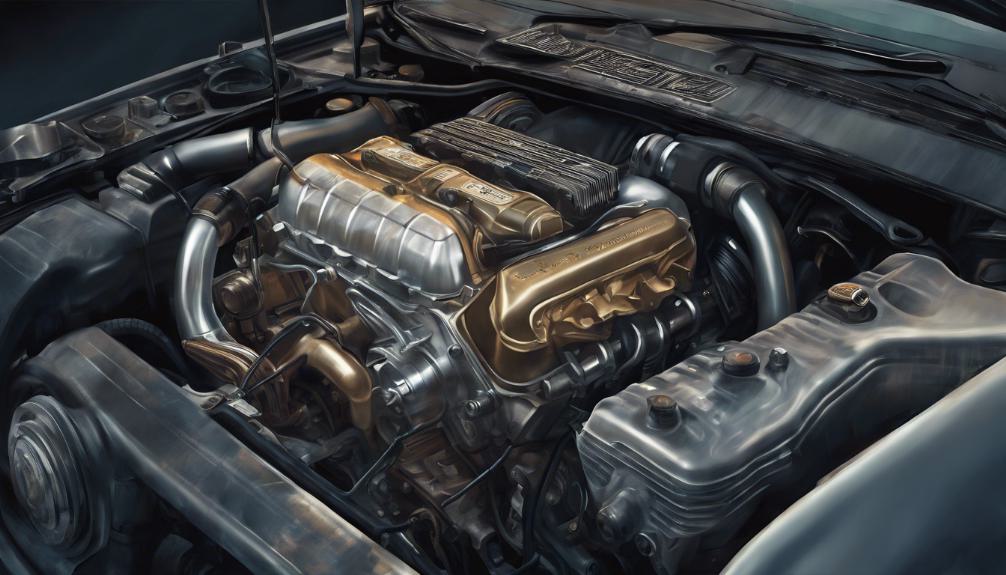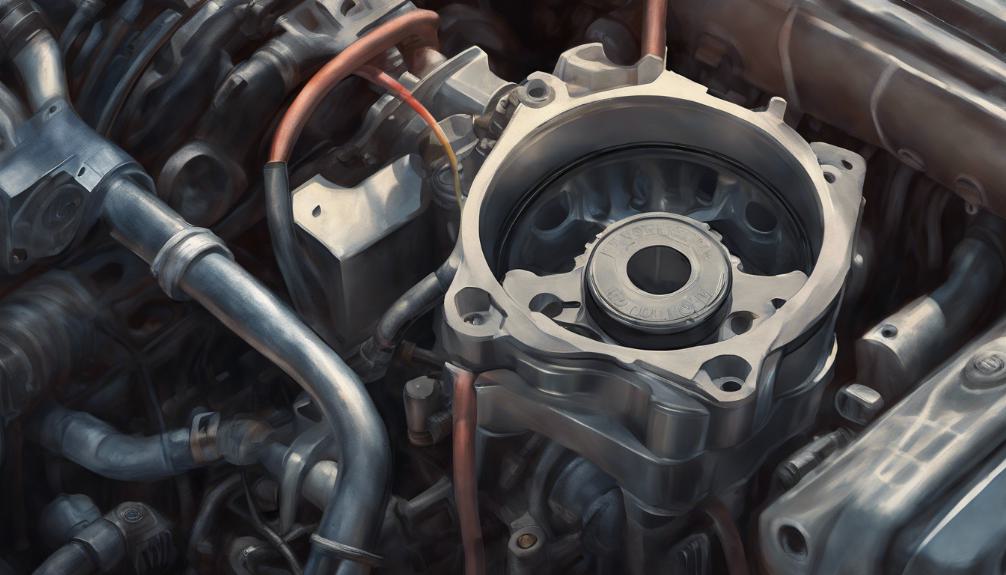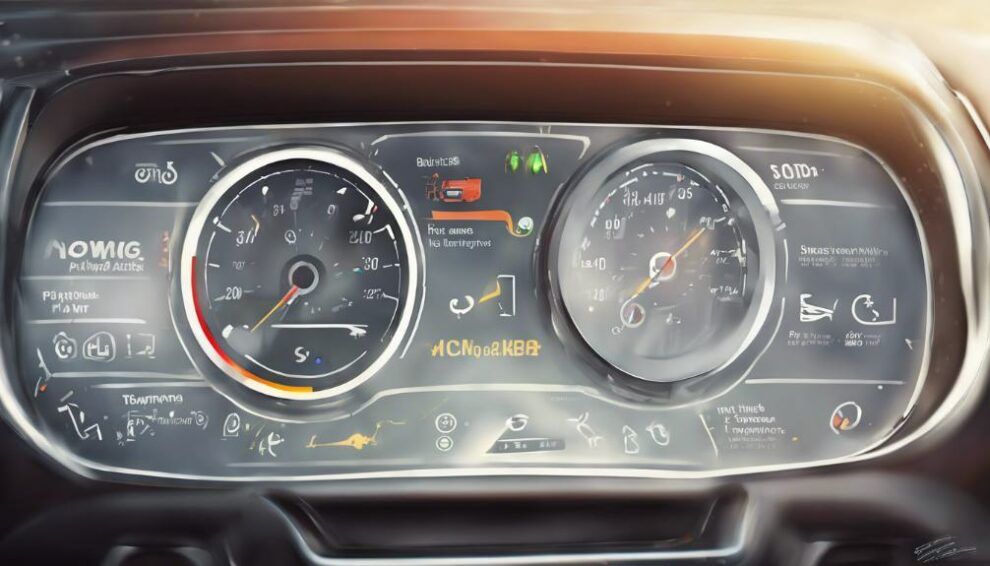Uncover the crucial car sensors for peak performance: Oxygen Sensor for air-fuel ratio, Crankshaft Position Sensor guarantees engine timing, Mass Air Flow Sensor regulates fuel intake, Manifold Absolute Pressure Sensor adjusts mixture. Knock Sensor identifies engine issues, Intake Air Temperature Sensor impacts fuel efficiency, Throttle Position Sensor controls engine response, and Engine Coolant Temperature Sensor maintains top-notch engine function. Learn how these sensors enhance your vehicle's efficiency and reliability on the road.
Key Takeaways
- Oxygen Sensor monitors exhaust oxygen for optimal air-to-fuel ratio and efficiency.
- Crankshaft Position Sensor synchronizes fuel injection and ignition for smooth engine performance.
- Mass Air Flow Sensor measures air volume for precise fuel injection adjustments.
- Knock Sensor detects abnormal combustion to prevent engine damage and optimize performance.
- Throttle Position Sensor regulates throttle for improved engine response and drivability.
Oxygen Sensor

Monitoring the oxygen content in your vehicle's exhaust system, the oxygen sensor guarantees an ideal air-to-fuel ratio for efficient engine performance. Signs of malfunction in this important sensor include a decrease in fuel efficiency, rough idling, or a noticeable decrease in engine power. It's essential to address these issues promptly, as a faulty oxygen sensor can lead to increased emissions and potential damage to the catalytic converter.
Regular maintenance is necessary to ensure your oxygen sensor functions at its best. Periodic inspections, typically during routine tune-ups, can help detect any early signs of malfunction. Replacing the oxygen sensor as recommended by your vehicle manufacturer is key to maintaining peak engine performance and reducing harmful emissions.
Crankshaft Position Sensor
The Crankshaft Position Sensor plays a critical role in determining the exact position of the crankshaft in your vehicle's engine. Here are three key points to help you understand its importance:
- Synchronization: The Crankshaft Position Sensor assists the engine control unit (ECU) in synchronizing fuel injection and ignition timing. This synchronization is essential for the engine to operate efficiently and smoothly.
- Diagnostic Troubleshooting: A faulty Crankshaft Position Sensor can lead to issues such as engine misfires, stalling, or difficulty starting the engine. Proper diagnostic troubleshooting is necessary to identify and rectify sensor-related problems promptly.
- Performance Tuning: Ensuring the Crankshaft Position Sensor is functioning correctly is crucial for optimal engine performance. Performance tuning often involves checking and calibrating this sensor to maintain the engine's efficiency and power output.
Regular maintenance and timely replacement of the Crankshaft Position Sensor can help prevent potential engine issues and keep your vehicle running smoothly.
Mass Air Flow Sensor

To understand the significance of the Mass Air Flow Sensor in your vehicle, consider its role in precisely measuring the volume of air entering the engine for efficient fuel injection. Positioned between the intake filter and intake manifold, the MAF sensor is essential for optimizing combustion efficiency. If your mass air flow sensor fails, you may experience decreased engine performance and fuel economy issues. This sensor is instrumental for the Vehicle Control Unit (VCU) to accurately adjust fuel injection based on air intake. Ensuring the proper functioning of the mass air flow sensor is vital for maintaining top-notch engine performance and efficiency.
For cleaning tips, it's recommended to use a specialized MAF sensor cleaner according to the manufacturer's instructions. Troubleshooting techniques involve checking for any loose connections, damaged wires, or debris that may affect the sensor's performance. Regular maintenance and inspection of the mass air flow sensor are key to preventing potential issues and ensuring your vehicle runs smoothly.
Manifold Absolute Pressure Sensor
Commonly overlooked by many drivers, the Manifold Absolute Pressure Sensor is a critical component in your vehicle's engine control system. Here are a few essential facts about this sensor:
- Measuring Engine Load: The Manifold Absolute Pressure Sensor detects pressure changes in the intake manifold, helping the engine control unit determine the engine load accurately.
- Backup Sensor: It acts as a backup for engines with Mass Air Flow sensors, aiding in diagnosing issues such as EGR system malfunctions, ensuring proper engine performance.
- Essential Performance: This sensor is vital in determining the air-to-fuel mixture, contributing to efficient engine performance, emissions control, and fuel efficiency.
When it comes to sensor diagnostics and troubleshooting techniques, understanding how to test the Manifold Absolute Pressure Sensor can help identify potential issues early on.
For those interested in performance tuning and modification tips, recalibrating the sensor or upgrading it to a more sensitive one can enhance engine responsiveness and efficiency.
Knock Sensor

Pivoting from the discussion on the Manifold Absolute Pressure Sensor, understanding the role of the Knock Sensor is important for maintaining peak engine performance and preventing potential damage. The knock sensor plays a significant role in detecting abnormal combustion signs like engine knocking or pinging. By monitoring engine vibrations, it helps prevent damage to engine components caused by detonation during combustion. This sensor ensures smooth and efficient engine operation by signaling the engine control unit to adjust ignition timing to prevent knocking. Ignoring a faulty knock sensor can lead to decreased engine performance and potential long-term damage.
When it comes to knock sensor diagnostics and troubleshooting, it's essential to pay attention to any warning signs that could indicate a malfunction. Moreover, the benefits of using a knock sensor in performance tuning are substantial. It allows for precise adjustments to ignition timing, fuel mixture, and other engine parameters, optimizing performance while ensuring engine longevity.
Intake Air Temperature Sensor
Playing an important role in optimizing engine performance and fuel efficiency, the Intake Air Temperature Sensor provides essential data to the PCM regarding the temperature of air entering the engine. Here are some vital points about this sensor:
- Impact on Engine Efficiency: The Intake Air Temperature Sensor influences the air-to-fuel mixture, directly affecting engine performance and fuel efficiency. It helps in determining the right amount of air needed for combustion, ensuring peak engine operation.
- Weather Related Effects: Changes in weather can impact the temperature of the air entering the engine, which in turn affects the sensor readings. Extreme temperatures or sudden weather shifts can alter the sensor's performance, potentially leading to incorrect fuel mixtures and engine issues.
- Sensor Troubleshooting Techniques and Performance Tuning Tips: Regularly checking the Intake Air Temperature Sensor for any signs of malfunction and using diagnostic tools can help in identifying and rectifying issues promptly. When performance tuning your vehicle, understanding how this sensor works can assist in fine-tuning the engine for better power delivery and efficiency.
Throttle Position Sensor

Optimizing your engine's performance and fuel efficiency further involves understanding the pivotal role played by the Throttle Position Sensor in regulating throttle blade positioning within the engine.
The throttle position sensor measures the position of the throttle blade, providing essential information for ignition timing and fuel delivery calculations. This sensor is integral for the operation of automatic transmissions, ensuring smooth shifts by monitoring throttle response.
Changes in throttle position directly impact engine performance, influencing factors such as engine speed and power output. A malfunctioning throttle position sensor can lead to poor engine performance and drivability issues, affecting your overall driving experience.
To maintain excellent engine performance, it's essential to monitor the throttle position sensor's functionality regularly. By ensuring this sensor is working correctly, you can enjoy improved throttle response and efficient engine performance, enhancing your driving satisfaction.
Engine Coolant Temperature Sensor
The engine coolant temperature sensor is an essential component in your vehicle's system, monitoring the temperature of the engine coolant. Here are three key points to help you understand its importance:
- Cooling system diagnostics: The engine coolant temperature sensor plays a pivotal role in diagnosing issues with your vehicle's cooling system. By monitoring the coolant temperature, it helps identify potential problems early on, allowing for timely repairs and preventing overheating.
- Temperature regulation: This sensor is responsible for regulating the temperature of the engine coolant. It guarantees that the engine operates within the ideal temperature range, which is essential for efficient performance and longevity.
- Engine performance optimization: By providing real-time data on coolant temperature, the sensor helps optimize engine performance. It communicates with the vehicle's computer to adjust fuel mixture, ignition timing, and other parameters, ultimately enhancing engine efficiency and fuel economy.
Proper functioning of the engine coolant temperature sensor is crucial for maintaining your vehicle's overall performance and reliability.
As an Amazon Associate we earn from qualifying purchases.










